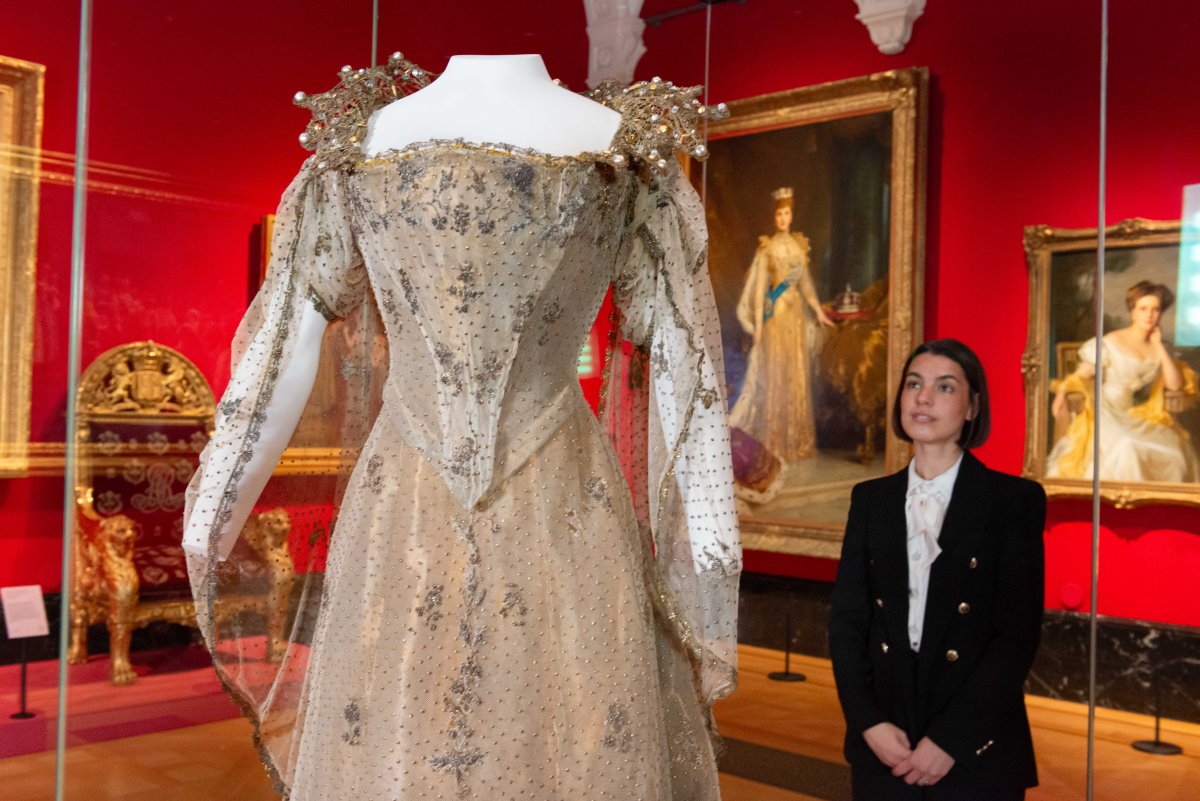
The new Royal Collection exhibition at Buckingham Palace features a whole range of surprises, including the display of an exceptionally special, fragile royal dress: the coronation gown worn by Queen Alexandra in 1902.
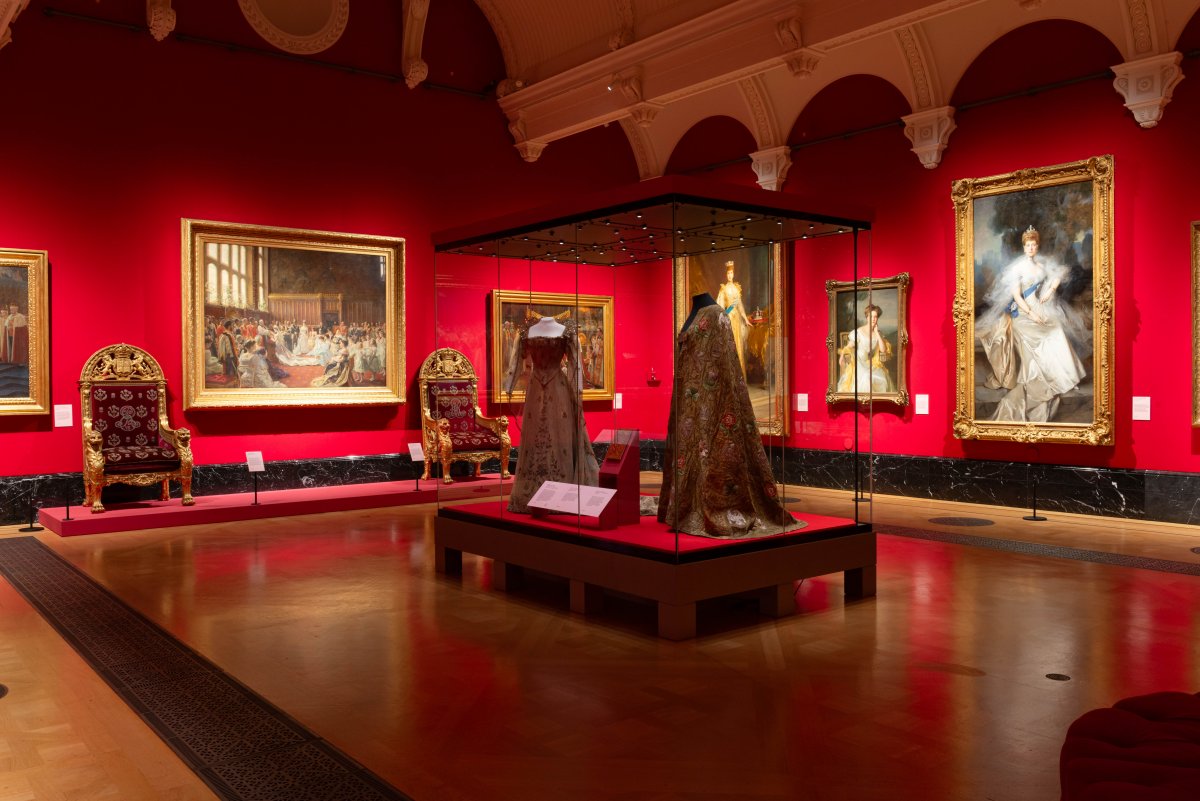
The Edwardians: The Age of Elegance at the King’s Gallery, Buckingham Palace features rooms full of artifacts and artwork connected to King Edward VII and Queen Alexandra, tastemakers who were extremely influential during the end of the nineteenth century and the dawn of the twentieth. One magnificent exhibition room features towering state portraits of the couple, along with their coronation thrones and parts of their coronation ensembles: Queen Alexandra’s coronation gowns (and some of her jewels!) and King Edward VII’s Coronation Mantle.
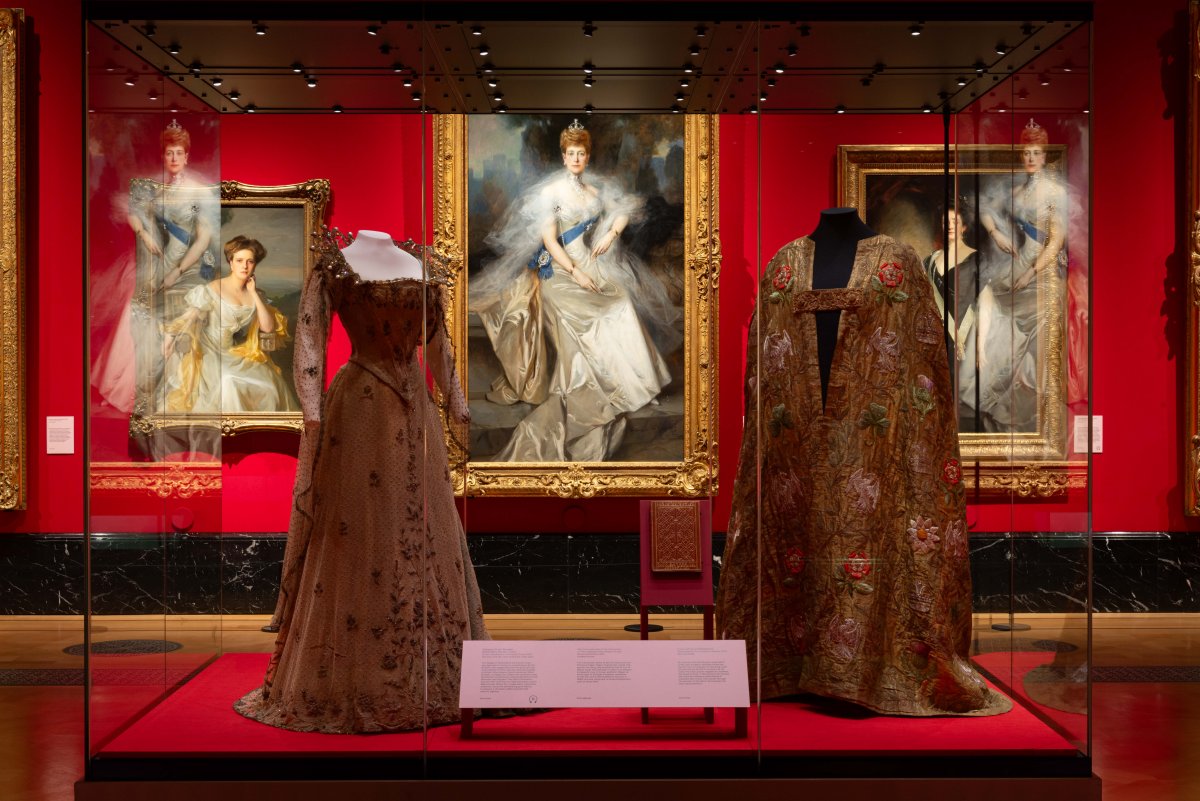
The ensembles are presented in a glass case in the middle of the room, allowing viewers to walk around them and see a 360-degree view of each spectacular piece. The gold cloth coronation mantle, shown on the right, was worn by the King during the service. It features embroidery done by artists from the Royal School of Needlework.
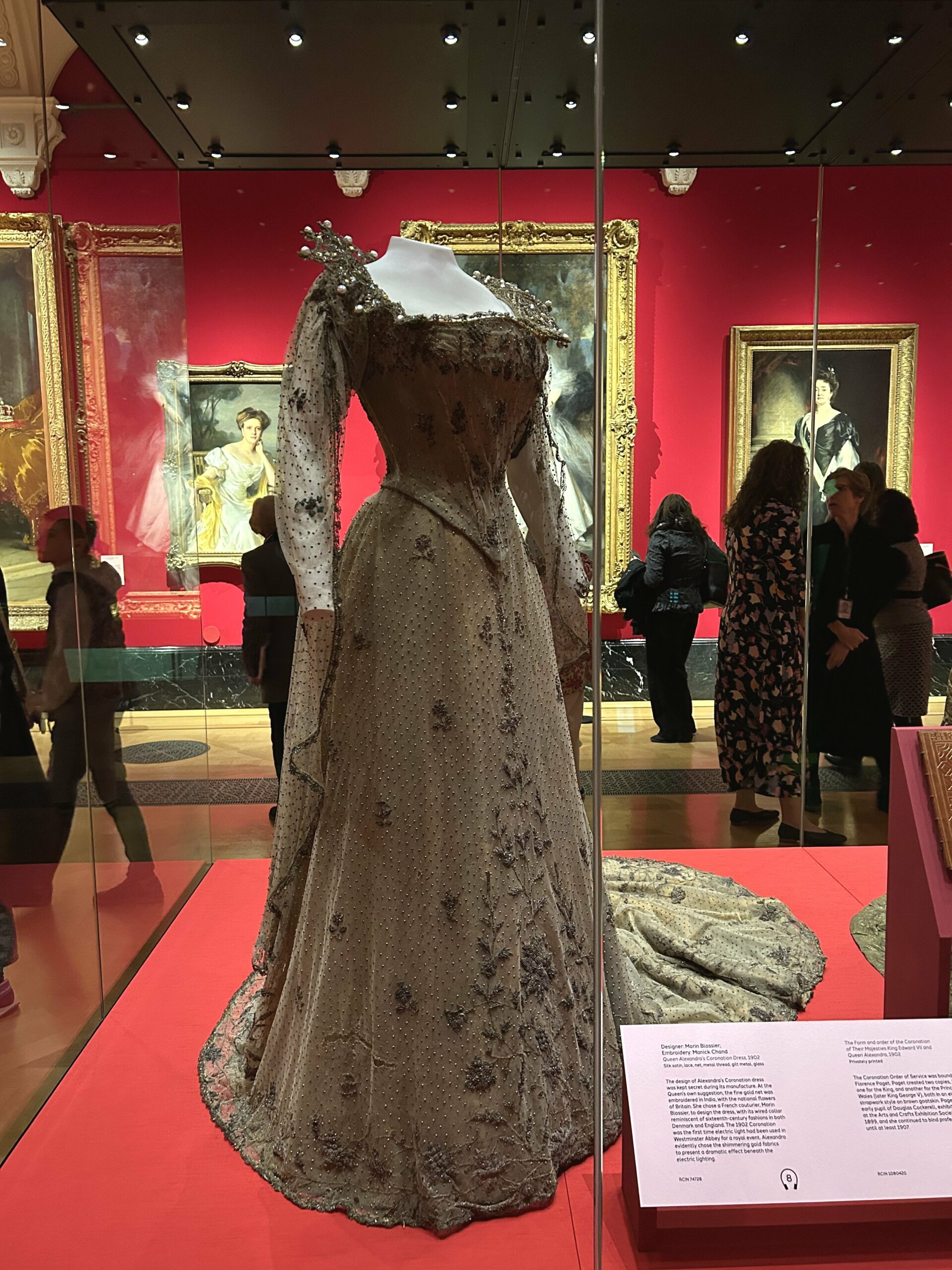
And on the left, of course, is Alexandra’s remarkable coronation gown. This is one of my photographs of the dress, taken during the exhibition’s press preview. Just as I arrived for the preview, the Royal Collection sent out a press release announcing that the gown would be part of the show. The gown, shown “for the first time in more than 30 years,” was part of a coronation that was “designed to be a public spectacle, heralding a glamorous new era for the royal family.”

While there were some clear precedents to follow where King Edward’s coronation attire was concerned, Queen Alexandra felt more freedom to innovate with her ensemble. The last time a queen consort had been crowned in Britain was the coronation of Queen Adelaide in 1831. Adelaide’s state portrait shows her wearing ermine-trimmed robes with an elaborate tulle gown, featuring a stiff collar, enormous sleeves, and gold embroidery. As you can see in this photograph of Alexandra’s dress from the royal collection, she took some cues from Adelaide’s dress while creating something totally new.
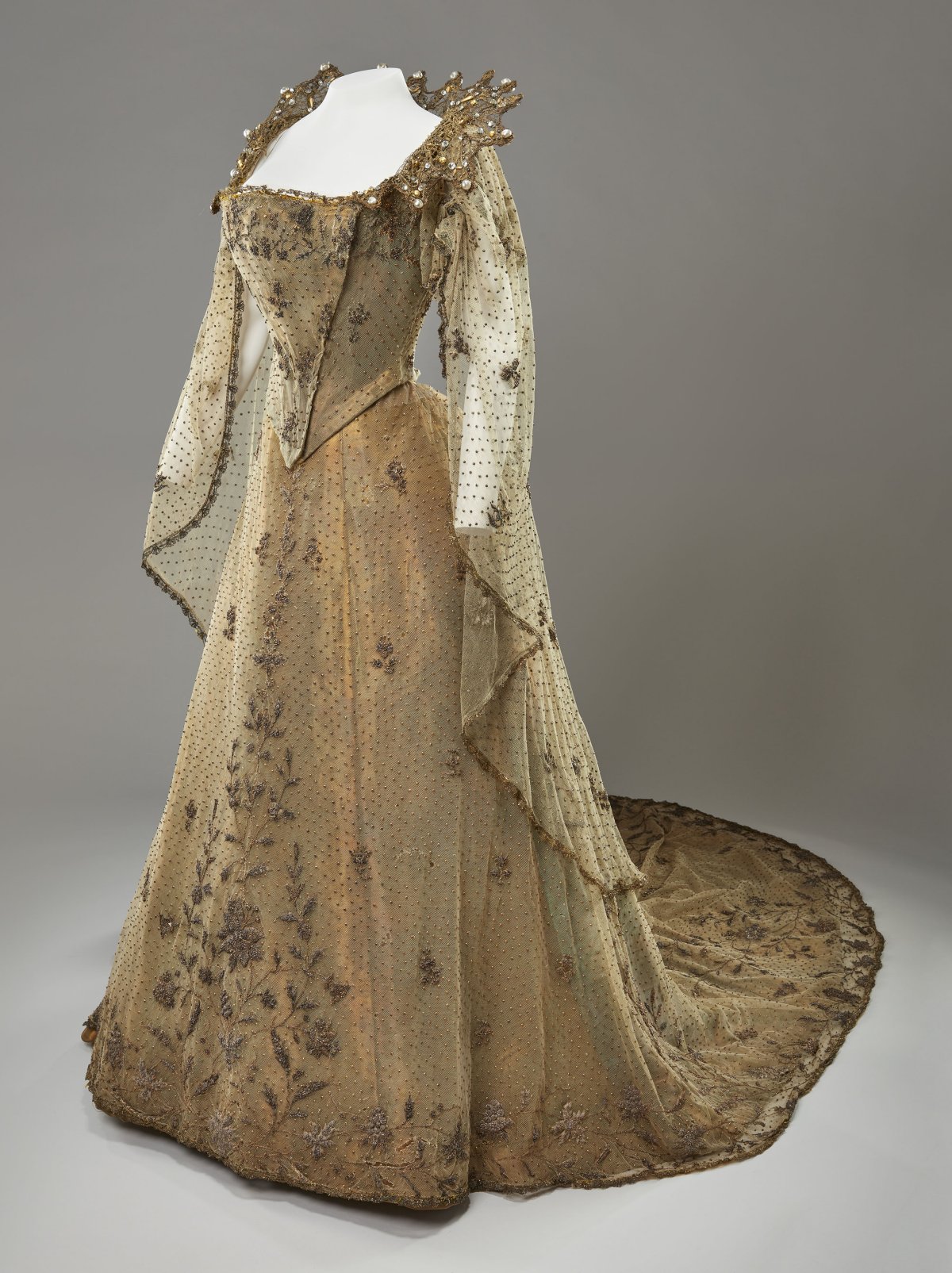
Alexandra’s biographer, Frances Dimond, shares a treasure trove of information about the creation of the dress. She writes that Alexandra “liked Lady Curzon, the Viceroy of India’s wife, and respected her fashion sense; she would be the perfect accomplice” in the creation of the coronation gown. Eventually, Alexandra settled firmly on the idea of an “Indian-inspired dress,” with fabrics sourced there by Lady Curzon and sent back to England for Alexandra’s inspection. Lady Curzon, who had been born in Chicago as Mary Leiter, daughter of one of the founders of Marshall Field, was indeed renowned for her sartorial style. She was more than happy to help Alexandra find something special and remarkable to wear for the coronation.
In June 1901, Alexandra’s Woman of the Bedchamber, Charlotte Knollys, wrote to Lady Curzon, explaining that Alexandra wanted a dress made of “net embroidered in gold & silver, with rose, shamrock & thistle. Could you therefore have a design made & send it to Her Majesty to look at. It must not be too ‘conventional’ or stiff but something in the ‘flowing’ style.” Lady Curzon was asked to conduct her mission in strict secrecy, lest any the fashionable ladies of London who would also be attending the coronation would try to have something similar made for themselves.
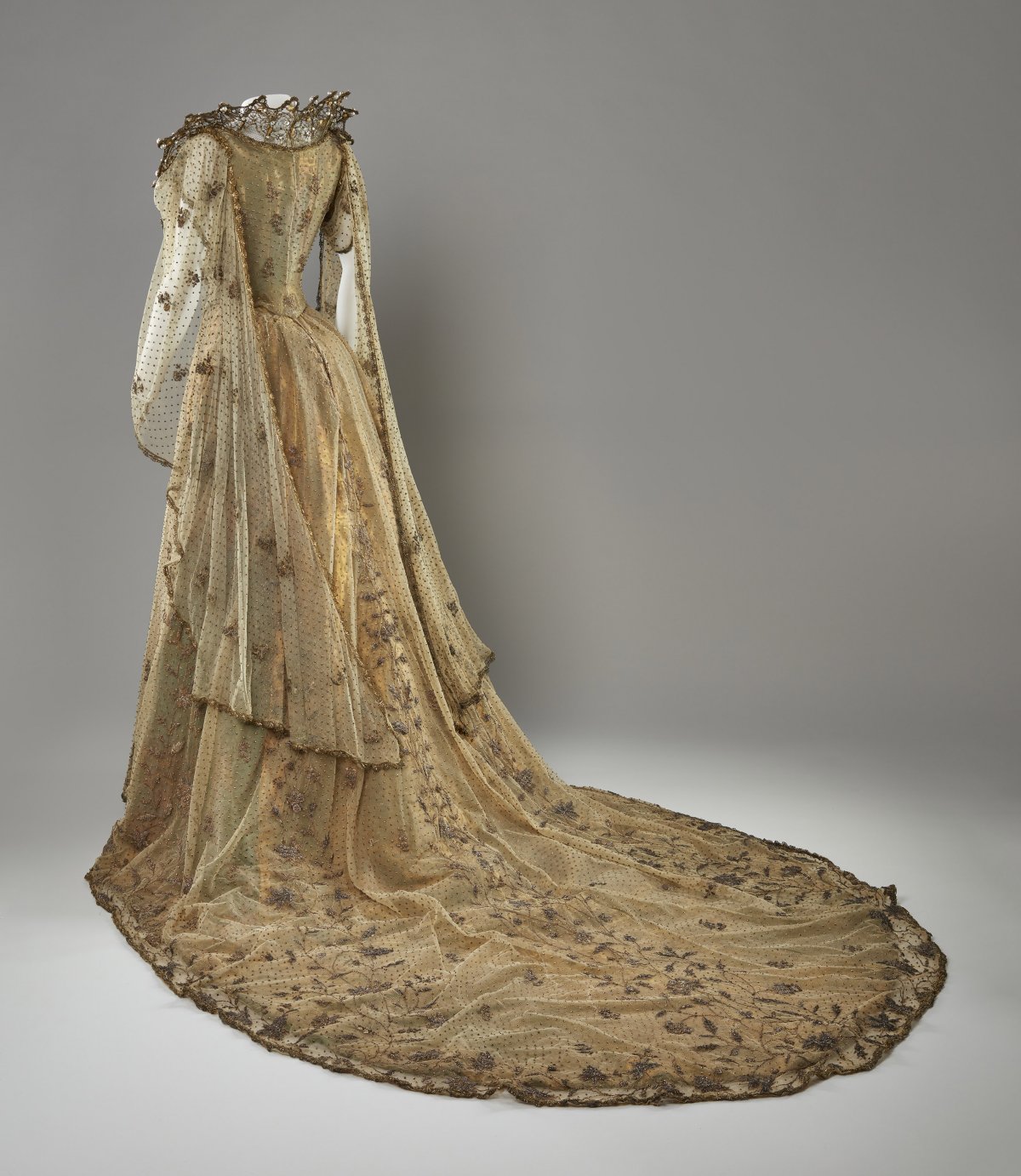
Alexandra was thrilled with the result. Dimond records a conversation between the Queen and Lady Curzon about the dress just before the coronation ceremony: “I have had the white & gold embroidered net made up over a cloth of gold which makes a brilliant effect, & the velvet mantle & train have been embroidered in gold to match in England, of English material. I am so proud of wearing an Indian dress for that great occasion & I hope you will make that known in India.”
Time has altered the color of Alexandra’s dress significantly, but in many photographs, you can still see the flash of the gold underskirt through the embroidered overlay. Forty skilled needleworkers in Delhi spent five months embroidering the gown’s gold net overlay, which was then shipped to Paris, where it was laid over cloth of gold and finished into the final dress design, overseen by a pair of couturier sisters, Victoire Morin and Marie Blossier.
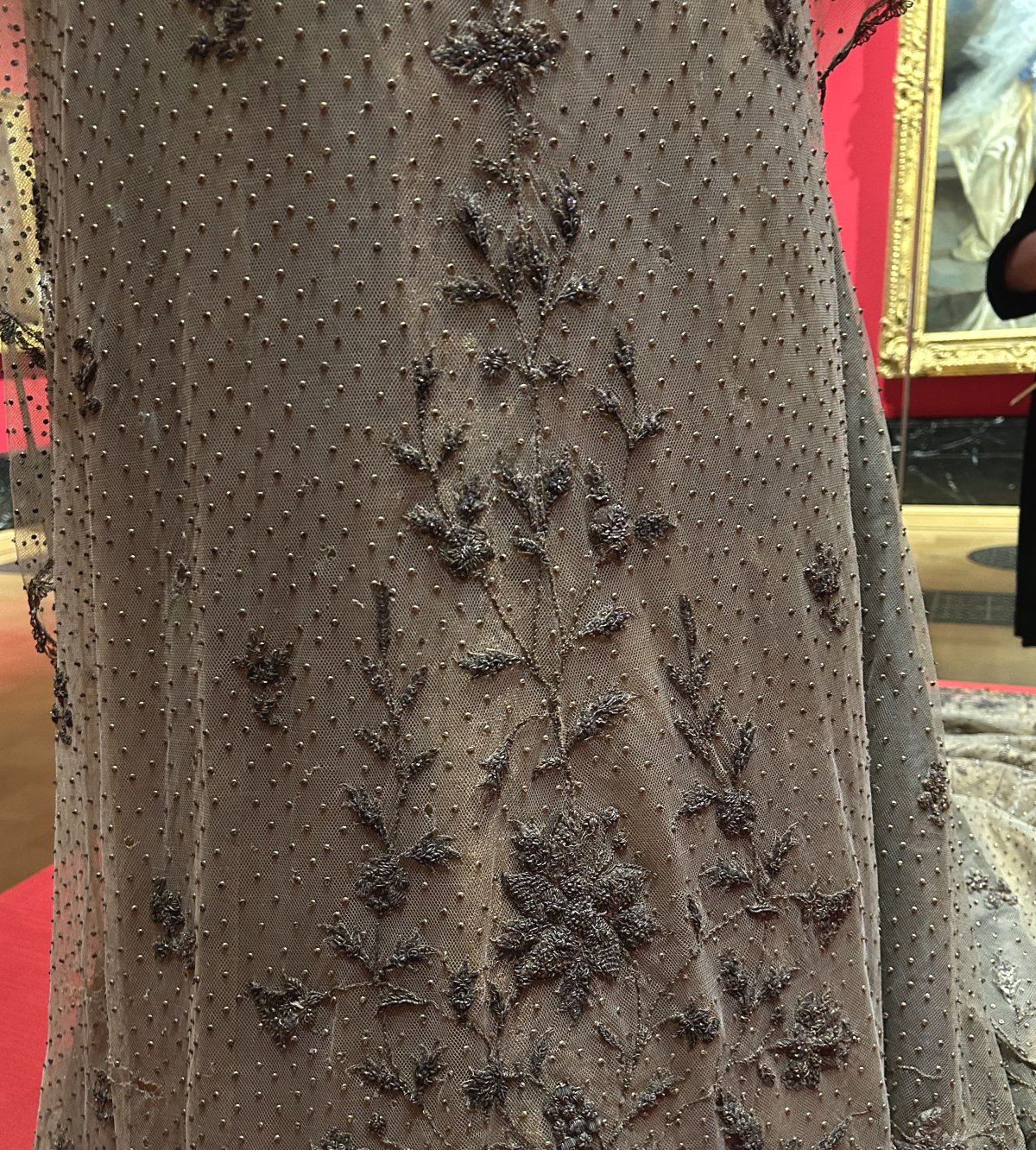
The embroidery that decorated the gown’s net overlay consisted of “thousands of tiny gold spangles.” The effect would have been remarkable, especially under the electric lights that had been installed in Westminster Abbey specially for the coronation. The new exhibition’s curator, Kathryn Jones, notes, “While it has darkened over time, Alexandra’s choice of a shimmering gold fabric would have been incredibly striking at the coronation; there are descriptions in contemporary newspapers of moments in the ceremony where the Queen appears in an extraordinary blaze of golden light, the dress glowing in the new electric lighting.”
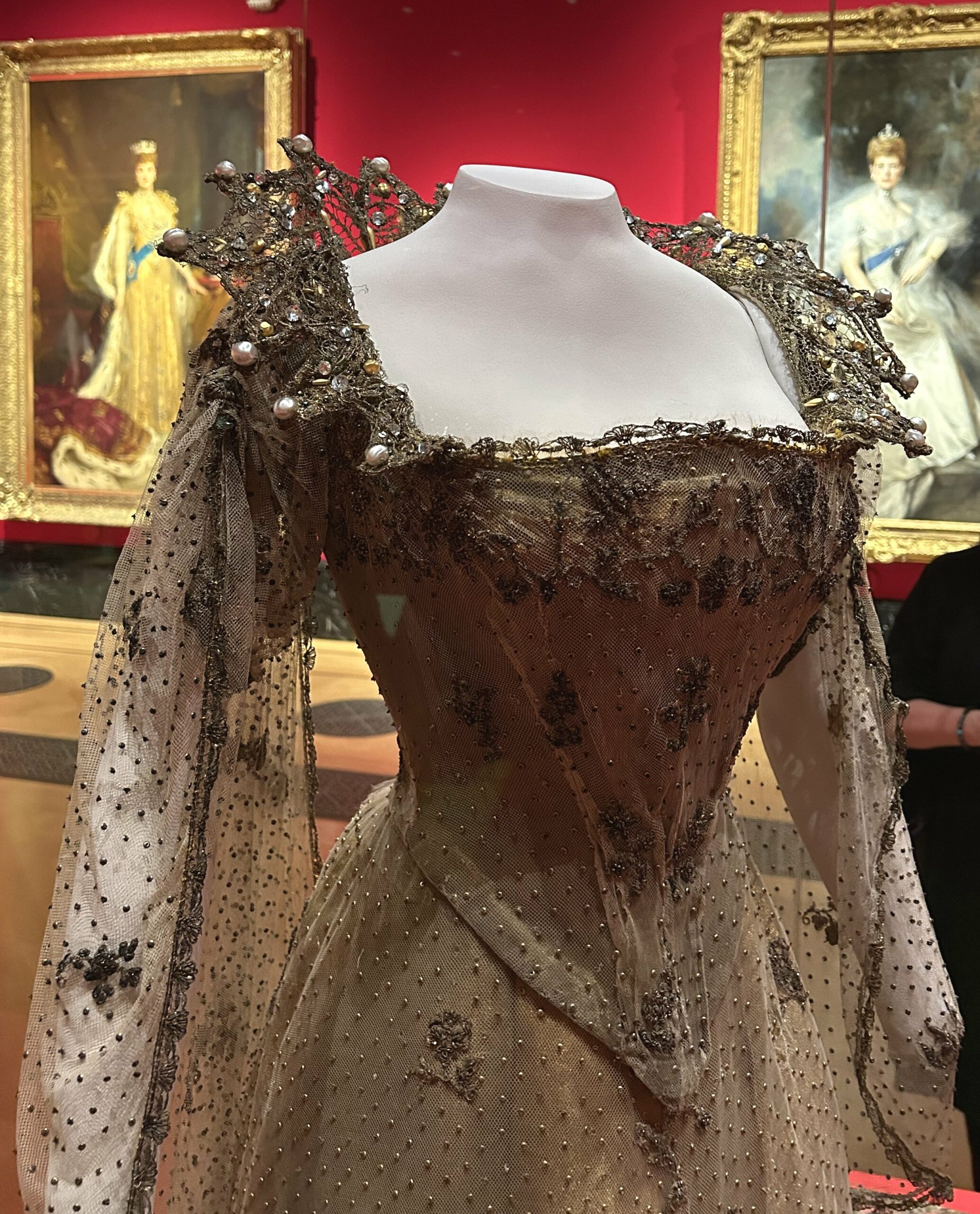
The dress also featured an eye-catching collar. Wire was used to keep the collar situated dramatically upright. Gemstones and pearls—all glass, I believe—are scattered across the collar. They would also have caught the light and sparkled immensely during the ceremony.
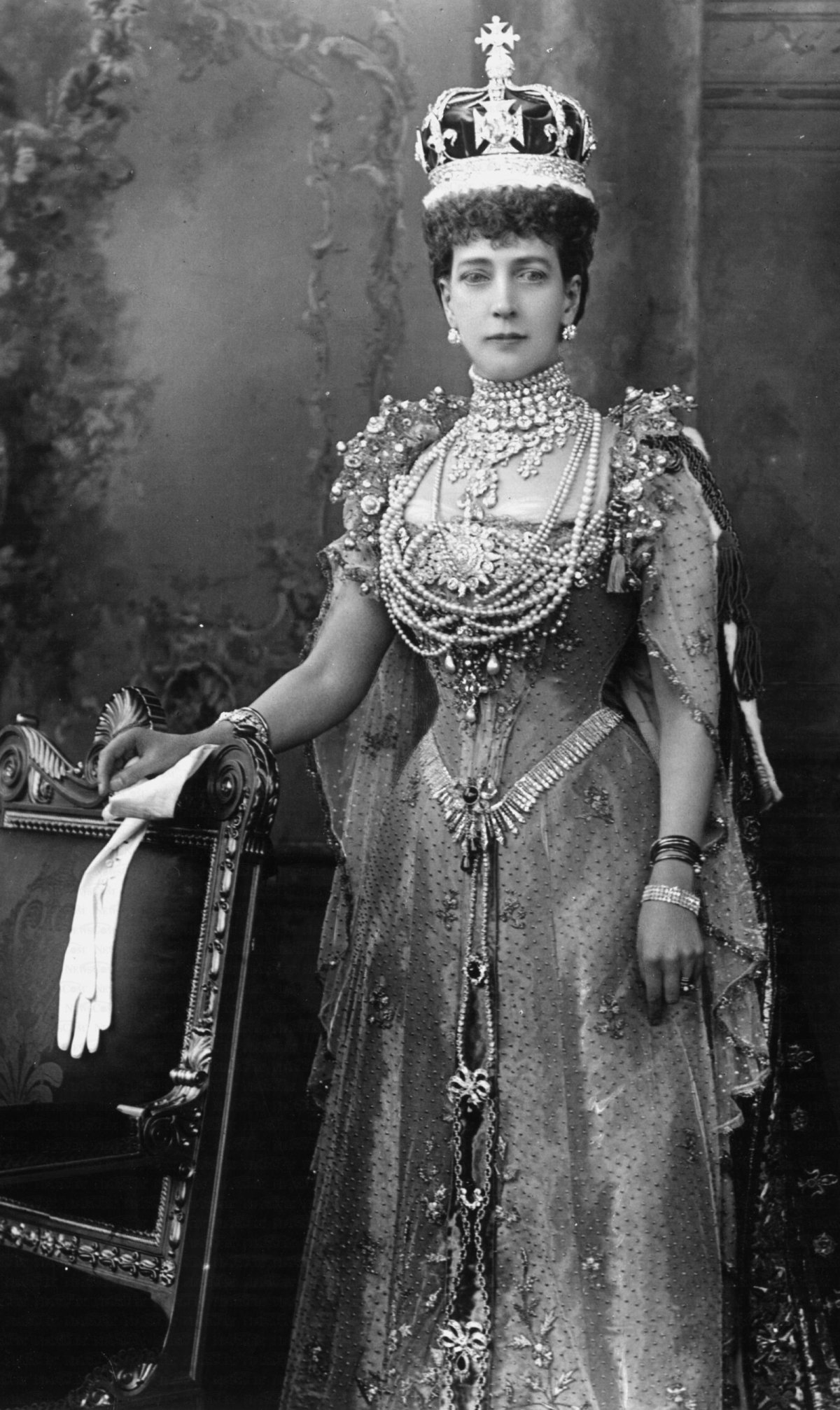
Alexandra supplemented the faux stones embroidered on the collar with real jewelry clusters from her collection. An incredible array of pieces were added to the dress on coronation day. Pearl and diamond clusters from her wedding necklace were scattered across the collar, and she wore the matching pearl and diamond cluster earrings from her wedding suite as well. Numerous necklaces of diamonds and pearls, including some said to have come from the collection of Mary, Queen of Scots, were stacked from her chin to her waist. Among the stack are the Coronation Necklace, as well as drops from the Coronation Earrings and more pendant sections that are now worn as earrings by the present Queen of Norway. Another necklace, Queen Adelaide’s Diamond Fringe, was used as a girdle around her waist.
Another pair of diamond-set chain necklaces cascade down the front of Alexandra’s skirt, with various Heirlooms of the Crown, including Queen Victoria’s Diamond Bow Brooches, attached for more sparkle. Perhaps the most magnificent bejeweled part of the jewelry ensemble is a stomacher featuring the enormous Cockade Brooch and the Dagmar Necklace. That necklace, along with Alexandra’s wedding pearls, is also featured in the Edwardians exhibition.

Perhaps the best representation that we have of the true color and dazzle of Alexandra’s coronation gown and jewels is the state portrait made by Luke Fildes. The gold color of the dress nearly leaps off the canvas, as does the unique purple-pink hue—called “petunia”—of Alexandra’s velvet robes.
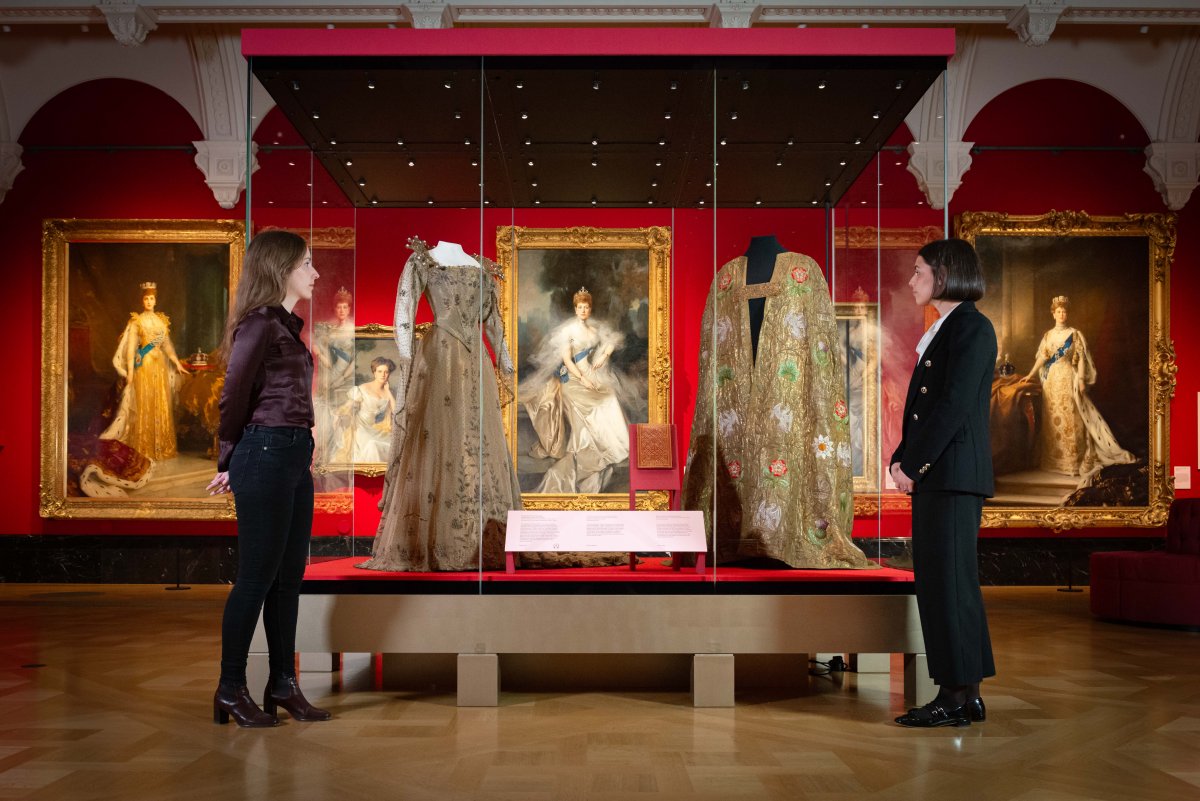
The Fildes portrait is also featured in the current King’s Gallery exhibition. It’s placed behind the coronation gown display, offering the viewer the chance to compare the real thing with the painted version. I’ve said it here multiple times already, and I’m sure I’ll say it again: there really is nothing like seeing all of these pieces in person. If you’re going to be in London this year, jump at the chance to marvel at the dress yourself!
Leave a Reply
You must be logged in to post a comment.